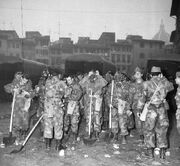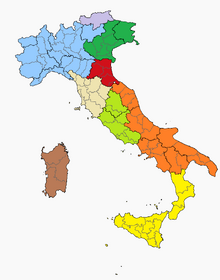Unità, Libertà, Independenza ("Unity, Liberty, Independence") | |||||||
| Anthem | "La Leopolda" | ||||||
| Capital (and largest city) |
Florence | ||||||
| Other cities | Pisa, Lucca, Viareggio, Livorno, Prato and Massa Carrara | ||||||
| Language official |
Italian | ||||||
| others | Tuscan | ||||||
| Religion main |
Christianity | ||||||
| others | Judaism, Atheism and others | ||||||
| Ethnic Group | Italians | ||||||
| Demonym | Tuscan | ||||||
| Government | Unitary semi-presidential republic | ||||||
| Legislature | Tuscan Parliament | ||||||
| President of the Republic | Vannino Chiti | ||||||
| Vice President | Marco Marcucci | ||||||
| Area | 22,987 km² | ||||||
| Population | 3,581,051 | ||||||
| Established | 2 June 1964 | ||||||
| Independence | from Italy | ||||||
| declared | 28 October 1963 | ||||||
| Currency | Tuscan Lira (£) | ||||||
| Time Zone | + 1 | ||||||
The Tuscan Republic or Tuscany is a survivor state located in the ex-region of Tuscany.
History []
When the bombs fell in Italy, Tuscany was not attacked by the Nuclear Bombs.
Despite it was a important region and the presence of Camp Derby, a NATO Base. The President of the region attempted to contact Rome or any authority outside of the Tuscany, though when no one has responded, they realized they were alone.
Lelio Lagorio have called for a special reunion of all the prefects of Tuscany and all military officials in the City of Florence.
From this meeting it was agreed that they would try and best accommodate the survivors as possible and create a new state. In order to do so agriculture was temporarily put in state control.
The fledgling government quickly created the Tuscan Armed Forces to keep the people safe in the region.
A New Republic[]
The 9th of April of 1964 the National Assembly of the Tuscany proclaimed the independence of the Tuscany from the Italian government, and any institution made to follow it. The new government was named the Tuscan Republic. The National Assembly held conference to write a Tuscan Constitution, based on the Italian constitution. The flag and the coat of arms selected were the flag and the coat of arms of the region Tuscany.
Lelio Lagorio was elected President of the Republic by the parliament, on the 1st of June of 1964. The new president ran on a platform of general reforms for improve and grown the tenor of life of the Tuscans.
Flood of Florence and expeditions.[]
In the Autumn of the 1966 the Arno and minor river of the Tuscany have overflowed and it have caused a flood who have hit Florence, Pisa and other city. The president and the vice-president have declared the state of emergency and it have mobilized the Armed Forces for help save population and Florence. Meanwhile, many young Italians have accorse at Florence to help the local population, they was the Angel of the Mud or Angeli del fango in Italian.
Italian Republic have send a unit of the Army for help Tuscany and many humanitarian and medical aid. The president of the Italian Republic Giorgio Almirante have visit Florence after the flood, and it have said is our duty help each other in this dark times.

Some "Angeli del Fango" who help the city of Florence in this dark times.
Sicily have send a ship of the Sicilian Navy with humanitarian and medical aid. Meanwhile, Giuseppe D'Angelo, president of the Sicilian Republic has sent a letter of condolence at the mayor of Florence for say how he is
San Marino have send a squad of soldiers for help Tuscany and the Capitan Regent have visit the city after the flood.
Monaco, Switzerland, France, Yugoslavia, Spain, and Austria have send humanitarian aid and money for help the young republic.
After the flood the city was destroyed, but thanks to the help from the Italian Republic, Sicily, San Marino and from other nation it was returned to its former glory.
Tuscany has made contact with San Marino, Monaco, Italian Republic, Sicily, Roman Republic, Austria and Switzerland. In the 1979 with the election of a pro-Italian party they have try at become part the Italian Republic, after some time a referendum was made for decide if remain independent or become part of Italy, and the 80% of the Tuscans choose to become part of Italy.
Constitution[]
Formally and according to the Tuscan Constitution (Constituzione Toscana) is organized as such:
The Parliament of the Italian Republic.
- President of the Republic (Presidente della Repubblica), elected by the citizens every seven years. The post is hold by Lelio Lagorio. The President cannot hold office in any other branch of power, and the office's salary and privileges are established by law.
- The National Assembly has a unicameral system, is elected by the people every four years. They have 100 deputies.
- Vice-President (Vice-Presidente), nominated by the President of the Republic. They were responsible for the administration of the Republic. Mario Leone is the new Vice-President.
- The Constitution establishes the Government of the Tuscan Republic as composed of the Vice-President and Ministers. The Vice-President form its cabinet. The appointee is a person instructed by the President of the Republic. Either way, the government must receive the confidence of the Parliament.
- The Constitution states that justice is administered in the name of the people and that judges are subject only to the law. So the judiciary is a branch that is completely autonomous and independent of all other branches of power, even though the Minister of Justice is responsible for the organization and functioning of those services involved with justice and has the power to originate disciplinary actions against judges, which are then administered by the High Council of the Judiciary, presided over by the President.
- There is only partial judicial review of legislation. Judicial review exists under certain conditions, established by the Constitutional Law, in the Constitutional Court, or Corte Costituzionale, which can reject anti-constitutional laws after scrutiny. When the Court declares a law unconstitutional, the law ceases to have effect the day after the publication of the ruling.
- The Constitutional Court is composed of 10 judges, one of which is the President of the Italian Constitutional Court elected from the court itself. One third of the judges are appointed by the President of Tuscany, one-third are elected by Parliament and one-third are elected by the ordinary and administrative supreme courts.
- According to the Constitution, any citizen that is fifty on the day of the election, and enjoys civil and political rights, can be elected President.
Political Parties []
The political parties of the National Assembly are:

The National Assembly of the Tuscan Republic
- Tuscan Communist Party (Partito Comunista Toscano) a anti-fascist party and a leftist party: 20/90
- Tuscan Christian Party (Partito Cristiano Toscano) a liberal and a rightist party: 35/90
- Tuscan Nationalist Party (Partito Nazionalista Toscano) a nationalist and a far-rightist party: 35/100
Administrative organization[]
The Tuscan Republic is divided into provinces and communes. The Provinces are in the charge of a Prefect, named by the President, who is in charge of all aspects of the state administration and public order. The chief magistrate of a commune is a mayor, elected by the citizens of a city or in special case by a prefect. He was assisted by a Municipal Consul, composed of five councilors named by the Mayor. Florence has a Mayor, elected by the Citizens, assisted by a consult of ten councilors named by the Mayor.
The Provinces are:[]
- Florence
- Pisa
- Prato
- Massa-Carrara
- Livorno
- Grosseto
- Siena
- Pistoia
- Lucca
- Arezzo
Economy []
The Tuscan Republic has a mixed economy system. Though traditionally the Tuscan economy has been dominated by agriculture and tourism. Tuscany suffered little damage from the war, and has a surplus of labor at the moment. Education, banking service, security service, telecommunication, transport, health care, social security and access to cultural resources are under the control of the state.
The Tuscan economy is based heavily on agriculture, naval industry, nuclear and hydro energy, light manufacture, viticulture, fishing and shipping. There is also a small tourism Industry.
Health Care[]
Health care is free and accessible for all the citizens of the republic, funded by the state through general taxation and direct revenues collected by local health, through prescription charges and other chargeable services.
Education[]
Schooling is required by law, and free, compulsory education is obligatory until 17 years of age. The Tuscan school system is divided into three stages of education:
- Primary education, which includes the kindergarten for three years and primary school, five years.
- Secondary education, which includes the secondary school level (Middle school) for three years, and the secondary school of second degree (High school) of five-year duration.
- Higher education, including the universities, the higher education in art, music and dance and vocational training.
The city of Florence, Pisa, Prato, Massa Carrara, Livorno, Grosseto, Siena, Pistoia, Arezzo and Lucca some universities. Florence has an officially sanctioned military academy, and Livorno an officially sanctioned naval academy.
The university of Florence and Pisa are the most old and prestigious in the world, and they are the most efficient and good according by a list of the best univerities in Europe made by the WEU, this univerities are also many frequented by many foreign students, mainly Europeans and South Americans, but also Americans or Arabs.
Mass media[]
In the republic, the official news agency is the Agenzia Stampa Toscana (AST). The most read newspapers are the Corriere della Maremma, the Repubblica Fiorentina, the Gazzetta dello Sport, Tuttosport and the Secolo XIX. There are no restrictions upon the press based on religion or other factors.
The Radio Televisione Toscana (RAT) is the property of the state. There are only a few private radio stations, though television and radio are fairly common and popular.
Military[]
The Tuscan Armed Forces (Forze Armate Toscane) is a armed force made up of volunteers. All citizens of 18 years can to serve in the Armed Forces for 18 months.

A group of Italian, Sicilian and Tuscan military during the flood of Florence of the 1966. They wear anti-gas Mask for don't be assume toxic or irradiated material.
The Tuscan Armed Forces are equipped with Beretta BM-59 as main rifle, and with the Beretta M54 as side arm, they have also use the MG 42/59 as squad weapons.
Armed Forces: []
- Tuscan Army (Esercito Toscano: 40,000 Military
- Tuscan Military Navy (Marina Militare Toscana): 15,000 Military
- Tuscan Military Air Force (Aeronautica Militare Toscana): 10,000 Military
Internal Security:[]
- Tuscan Police (Polizia Toscana): 20,000 Policemen
| |||||||||||||||||||||||||
| |||||||||||||||||



